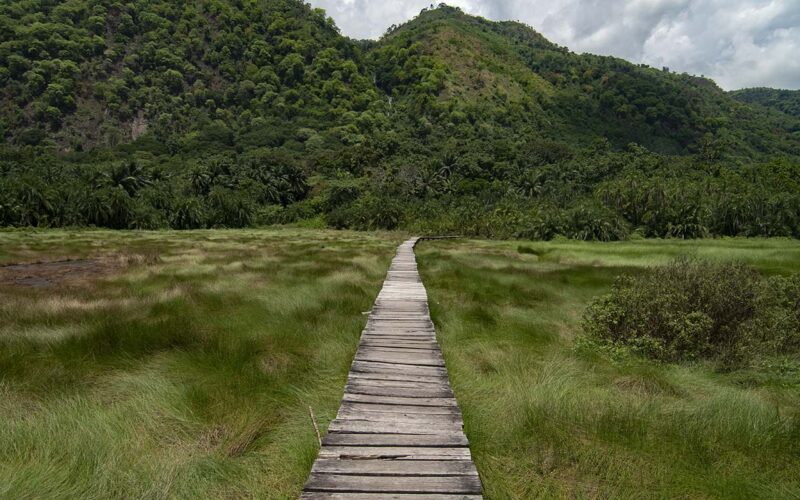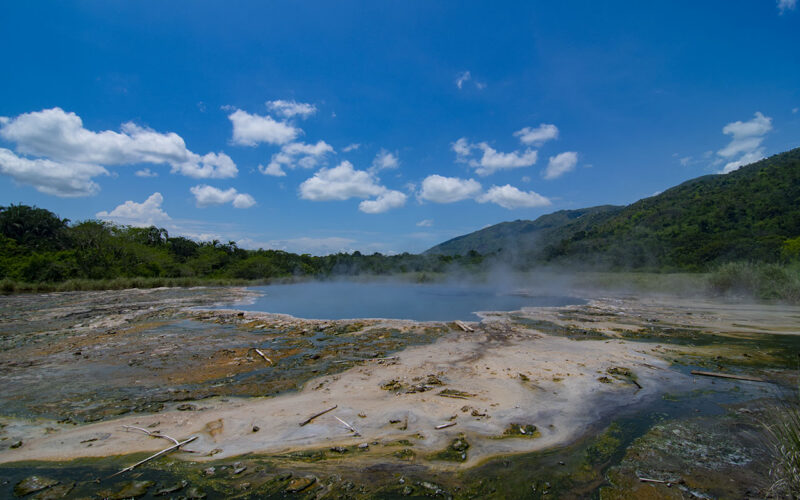Semuliki National Park stretches across the rift valley floor ranging at 670m-760m from the northern foothills of the towering Rwenzori mountain ranges on to the southern edges of Lake Albert. Semuliki Forest is an extension of the Ituri forest of Congo into Uganda and a popular birding hotspot to bird watchers seeking out the diverse bird specialists unique to this Guinea-Congo habitat. The forest also protects several mammals including some rare primates like the Mona Monkey only known from here in Uganda.
Within this forest’s mineral encrusted swamp is a pair of magnificent hot springs, with a 1m geyser spilling where temperatures reach u to 900C. Originally occupied by Africa’s oldest tribe the Pygmies, the 220km2 park was gazetted in 1993 as a protected national park for its biodiversity.
Quick Facts
- Size: 220km2
- Vegetation type: Lowland Forest
- Altitude: 670-700m
- Birds: 450 species
- Mammals: 60 Mammals

Things to do at Semuliki National Park
Birding in Semuliki National Park (Birder’s Haven)
The avian-rich moist-semi deciduous rain forest of Semuliki is an easterly extension of the Congo forests fully stocked with as many as 50% of the entire Congo Forest bird species. Excellent trails explore these lowland forests where a checklist of 450 species recorded here includes a full 35 Guinea-Congo species occurring nowhere else in E. Africa while others have limited distribution elsewhere. River Semuliki to which the forest is named, meanders on its western border creating several ox-bow lakes that flourish with diversity before emptying into L. Albert in the north. These marsh and swamp shores of Lake Albert is a good place to see the Shoebill and other swamp restricted species.
Top Semuliki National Park Bird Highlights
The Semuliki bird highlights include Rufous-crowned Eremomela, Red-rumped Tinkerbird, Spot-breasted Ibis, Black-throated Coucal, Ituri Batis, Chestnut-breasted Nigrita, Golden-naped Weaver, Orange-cheeked Waxbill, Chestnut-flanked Goshawk, Red-chested Goshawk, Red-thighed Sparrowhawk while Congo Serpent Eagle is rare. The characterful Nkulengu Rail is a tough job but Long-tailed Hawk, Hartlaub’s Duck, Red-thighed Sparrowhawk, Yellow-throated Nicator are regular. Hornbills represented in Dwarf and Eastern Little Hornbills, Eastern Piping, Eastern Long-tailed and Black-casqued Hornbill.
More good specialists in these lowland forests include; Red-tailed Ant-Thrush, Forest scrub-Robin, African Piculet, Black-winged Oriole, Spotted Honeyguide, Lyre-tailed Honeyguide, Lowland Akalat, Fiery-breasted Bush-shrike, Purple-throated Cuckooshrike, Red-eyed Puffback, Blue-billed Malimbe, Capuchin Babbler, Simple Greenbul, Lemon-bellied Crombec, Grey and Yellow Longbill, Leaf-love, Crested Malimbe, Rufous-sided Broadbill, Rufous-bellied Helmetshrike and more. The little-known trio of Black-eared Ground-Thrush, Oberlander’s Ground-Thrush and Grey Ground-Thrush are ticked off in these Semuliki lowland forests.

Explore the Sempaya Hot Springs at Semuliki National Park
Veiled in a thick cloud and surrounded by the forest is a cluster of hot springs, a popular spot with geysers gushing up to 2m in the air with hot water over 100 degrees C. The pair of hot springs which are respected as a female and male is an important cultural site for the local Bamba and Bakonjo people.
